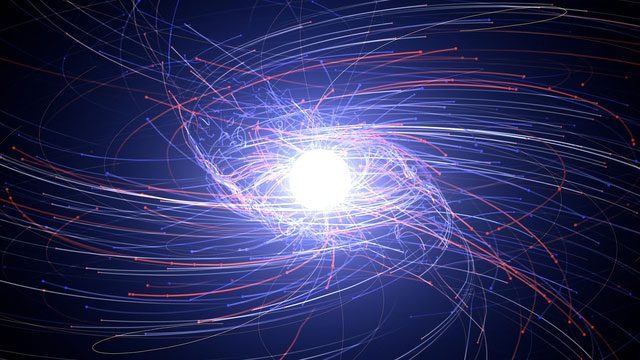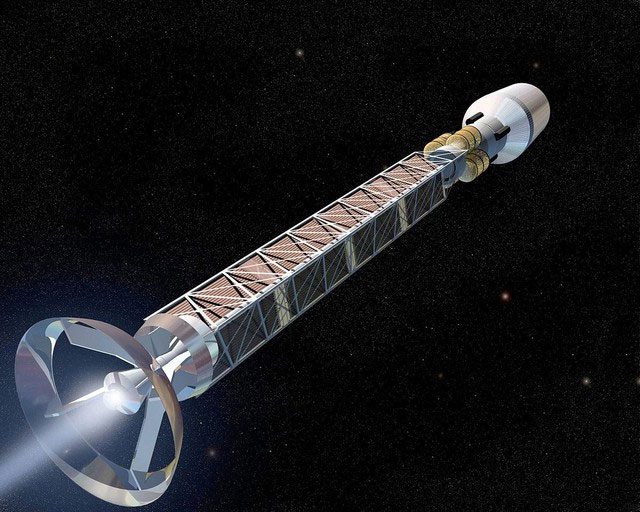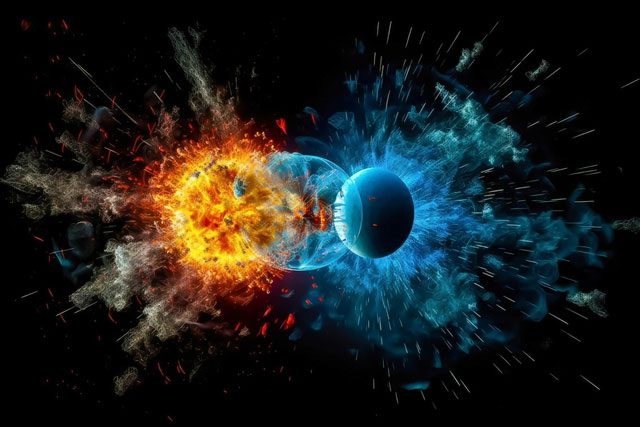Modern science believes that even a small amount of antimatter can release enormous energy, making it an ideal and perfect energy source.
The reason antimatter is considered a high-energy source is that antimatter and matter annihilate each other upon contact. In a fleeting moment of annihilation between matter and antimatter, a violent explosion occurs, releasing all the energy from the combined mass of matter and antimatter.
This means that the collision of 1 gram of matter and 1 gram of antimatter can release the full energy equivalent of 2 grams of mass. According to the mass-energy equivalence formula, this can release 1.8 x 1014 J (Joules), equivalent to the energy of 50 million kilowatts of electricity or the explosion of 43,000 tons of TNT.

Antimatter and matter annihilate each other upon contact. (Illustrative image).
If humanity wants to reach Mars now, the chemical fuel consumed by spacecraft would require tens of millions of tons, while the energy from antimatter would only be measured in grams.
The cleanest and most efficient energy that humans have discovered and are currently trying to use is nuclear fusion. However, the mass-energy conversion efficiency of this process is only seven thousandths, which is still far lower than the 100% conversion rate of the reaction between antimatter and matter.
Thus, the annihilation of matter and antimatter is a perfect process of mass-energy conversion that leaves no trace in this world, meaning there is no pollution. If this energy source could be harnessed for human existence and development, it would certainly set a ceiling for energy usage.

Antimatter truly exists. (Illustrative image).
So, does antimatter exist in this world?
Of course, it does. Scientific research has demonstrated that various fundamental particles that make up all matter in the world have corresponding antiparticles. Scientists have produced antimatter in laboratories, and although this antimatter is currently only at the atomic and subatomic levels, it is sufficient to prove that antimatter is real.
What is called antimatter is the opposite of normal matter in our world, and this opposition is not superficial but rather intrinsic to its composition. For example, all visible matter is made up of atoms, which consist of atomic nuclei and electrons. Protons in the nucleus carry a positive charge, while electrons that orbit the nucleus carry a negative charge. When positives and negatives are balanced, matter becomes electrically neutral, while antimatter has negatively charged nuclei and positively charged electrons.

It can only exist in subatomic form. (Illustrative image).
Today, the global aerospace industry is rapidly developing, with landings on the Moon and Mars becoming a reality; however, it is still impossible to acquire even one gram of antimatter, let alone a milligram.
This is due to the extremely low amount of antimatter in our world, which can only exist in subatomic form. The detected antimatter particles include antihydrogen atoms, positrons, antiprotons, alpha antiparticles (antihelium-4), etc. The heaviest antimatter is antihelium-4, requiring 1.505 trillion particles to have a mass of 1 gram.
Currently, these antiparticles are mostly produced artificially by consuming an enormous amount of energy, and the quantity produced is measured in particle units.
Moreover, the preservation of antimatter is extremely challenging, as matter is ubiquitous in our world, and antimatter will annihilate upon contact with matter the moment it is created, lasting no more than a thousandth of a second.
At present, scientists are striving to devise ways to preserve and utilize the antiparticles they have collected. To do this, scientists need to create at least two conditions to allow antimatter particles to remain in this world a little longer.
These two conditions are:
- First, we must attempt to reduce the temperature of these particles to 0.5K, or -272.65 degrees Celsius, extremely close to absolute zero, so that these antiparticles are in a low-energy state and move slowly.
- Second, we need to utilize the weak magnetism of these particles to create a magnetic trap, also known as a magnetic bottle, to confine these antiparticles without any contact with matter.

So far, the total amount of antimatter collected by scientists is only 15 nanograms. (Illustrative image).
However, with current human technology, meeting both of these conditions is not feasible. Because this technology is so challenging, storing these particles in a magnetic trap for an extended period is incredibly difficult. Scientists have worked diligently for decades, and the storage time for antiparticles is hard to extend. Currently, the maximum storage time can only meet some research needs.
Scientists worldwide have utilized enormous resources and spent countless amounts of money on research for decades, with the total amount of antimatter they have collected being only 15 nanograms.
Current human technology can only use the Large Hadron Collider to produce antimatter particles; scientific calculations indicate that it would take a Large Hadron Collider colliding for a thousand years to produce one microgram of antimatter.
Therefore, until there is a breakthrough in existing theories and technologies, the prospect of humanity using antimatter remains a dream and cannot become a reality.

The prospect of humanity using antimatter remains a dream. (Illustrative image).


















































